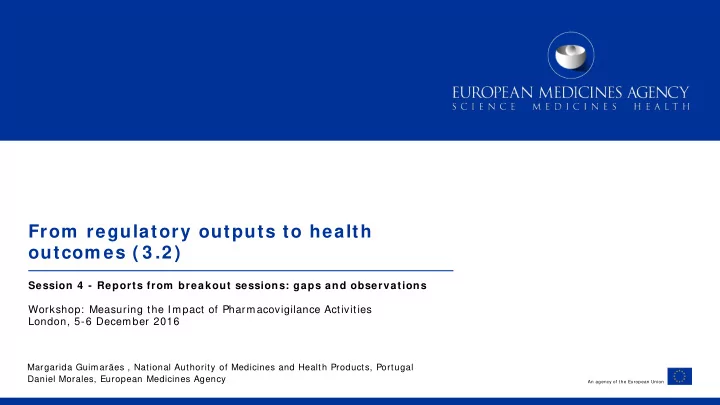

From regulatory outputs to health outcom es ( 3 .2 ) Session 4 - Reports from breakout sessions: gaps and observations Workshop: Measuring the Impact of Pharmacovigilance Activities London, 5-6 December 2016 Margarida Guimarães , National Authority of Medicines and Health Products, Portugal Daniel Morales, European Medicines Agency An agency of the European Union
Session 3 .2 Topics 1 . Methods to go from process outcom es to health outcom es ( e.g. use of surrogate m easures and interrupted tim e series) Stephen Evans, London School of Hygiene and Tropical Medicine 2 . Study of liver function m onitoring in patients receiving agom elatine in the Estonian Health I nsurance ( EHI ) database Maia Uusküla, State Agency of Medicines Estonia 3 . Modelling m ethods to estim ate the public health im pact of regulatory decisions Saad Shakir, Drug Safety Research Unit 1
1 . Discussion points • Is it possible to relate process outcomes to health outcomes? • Are the methods for interrupted time series (ITS) adequate to estimate effects of regulatory actions? • Can major regulatory decisions be accompanied with plans to measure the public health impact? • What approaches can be used to estimate the effectiveness of RMM such as additional monitoring • What type of evidence for safety is used to support regulatory decisions • Quantifying absolute and relative risk from evidence used in PhV decision making • Seek to identify predictive modelling methods to measure the public health impact in terms of mortality and serious morbidity 2
2 . Key findings Methods to go from process outcomes to health outcomes (e.g. use of surrogate measures and interrupted time series) • Effect of media on statin prescribing • Used an ITS regression modelling approach Study of liver function monitoring in patients receiving agomelatine in the Estonian Health Insurance (EHI) database • Adherence to the liver monitoring scheme was shown to be poor • Further information is required to inform whether regulatory action is needed Modelling methods to estimate the public health impact of regulatory decisions • Complicated process which needs a collaborative process for the design 3
3 . Challenges and gaps • Difficulty in measuring the intended health outcomes • Challenges to specify time periods • Difficulty in modelling accounting the impact of the confounding factors • Limitations of ecological studies • Other methods may be required to fully understand the effectiveness of RMM • Importance in measuring the variation (e.g. sub-populations) 4
4 . Recom m endations and conclusions • Modelling approaches such as ITS are a potentially useful method • Important to ensure key modelling assumptions are met • Consider examining subpopulations to detect changes in health outcomes • Potential usefulness of negative control • Importance of patient characteristics • May need other methods e.g. survey qualitative to understand reasons • Study methods – when can be used 5
Recommend
More recommend